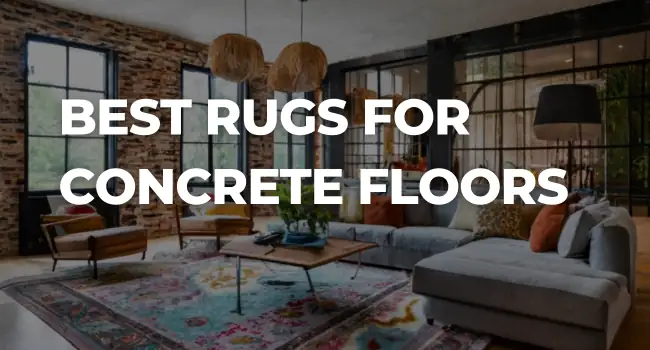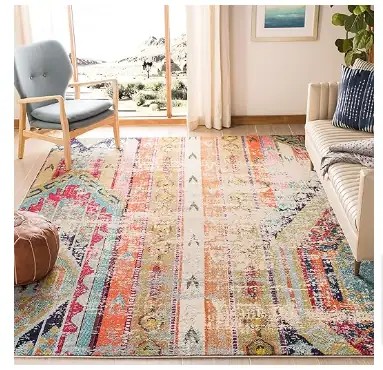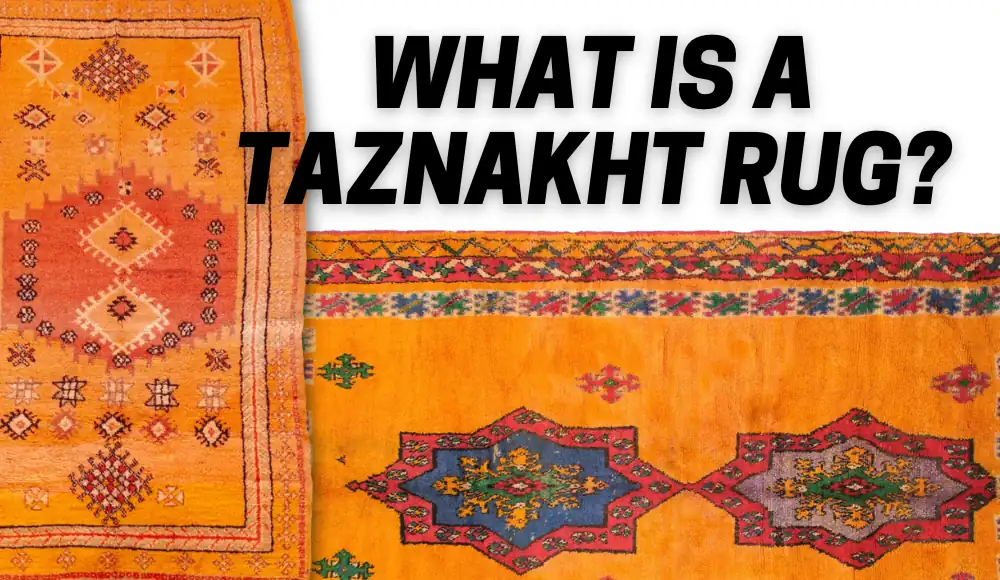Last updated on October 28th, 2023 at 01:02 pm
When it comes to adding warmth, style, and comfort to your concrete floors, rugs for concrete floors are your secret weapon. They not only provide insulation but also enhance the aesthetics of any room. In this guide, we’ll explore various aspects of choosing and maintaining the best rugs for concrete floors. Whether you’re wondering if you can put an area rug on a concrete floor or searching for the right rug material, we’ve got you covered. Let’s dive in!
Can I Put an Area Rug on Concrete Floor?
Absolutely! Concrete floors can benefit greatly from the addition of area rugs. Not only do they create a cozy atmosphere, but they also protect your feet from the cold, hard surface. Now, let’s delve into the specifics.
What Are the Best Types of Rugs for Concrete Floors?
- Area Rugs: These are versatile and come in various sizes, making them suitable for any room.
- Carpet Tiles: Ideal for those who prefer a more permanent option, carpet tiles can be laid directly on the concrete.
- Runners: These long, narrow rugs are perfect for hallways or alongside your bed.
How to Choose the Right Rug for Concrete Floors?
Selecting the perfect rug involves considering several factors:
Size:
- Measure your room and determine the right rug size. A small rug can make a room look disjointed, while an oversized one may overwhelm the space.
Material:
- Opt for materials like wool, cotton, or synthetic blends for durability and comfort.
Style:
- Choose a rug that complements the room’s décor and your personal style. From traditional to modern, there’s a rug for every taste.
What Color Rug to Use on the Concrete Floor?
When deciding on a rug’s color for your concrete floor, consider the room’s color scheme. Neutral shades like beige, gray, or soft blue work well, as they can complement various design styles.
Are Anti-Slip Rugs Necessary for Concrete Floors?
Anti-slip features are essential, especially if your rug is placed in high-traffic areas. Look for rugs with a non-slip backing to prevent accidents and ensure safety. Here are some considerations to help you determine whether anti-slip rugs are necessary for your concrete floors:
- Use Case: Consider the purpose of the area with the concrete floor. High-traffic areas, such as entryways or hallways, may benefit from anti-slip rugs to prevent slip and fall accidents. In contrast, areas with minimal foot traffic may not require them.
- Flooring Finish: The type of finish on your concrete floor can affect its slipperiness. Polished concrete tends to be more slippery than textured or rougher concrete surfaces. If your concrete floor is particularly smooth, anti-slip rugs can provide added safety.
- Environmental Conditions: Consider the environmental conditions in the area. Concrete floors can become slippery when wet, whether due to spills or high humidity. If your concrete floor is exposed to moisture, anti-slip rugs can help prevent accidents.
- Maintenance: If the concrete floor is difficult to keep dry or clean, anti-slip rugs can be a practical solution. Rugs are easier to maintain and replace than modifying the concrete surface itself.
- Budget and Aesthetics: Anti-slip rugs offer a cost-effective way to enhance safety. They are also available in various styles and designs, allowing you to choose rugs that complement the aesthetics of the space.
- Safety Concerns: If you have children, the elderly, or individuals with mobility issues in your household, adding anti-slip rugs in areas where they walk can enhance safety and reduce the risk of accidents.
- Regulations and Codes: Depending on your location, building codes and regulations may require the use of anti-slip measures in certain settings, such as commercial spaces or public areas.
What Are the Benefits of Using Rugs on Concrete Floors?
Rugs offer a multitude of advantages for concrete floors:
- Improved Comfort: Concrete floors can be hard and cold, especially in areas like basements or garages. Rugs add a layer of softness and warmth underfoot, making the space more comfortable.
- Enhanced Safety: Rugs can provide traction and help prevent slips and falls, which can be a concern on smooth or polished concrete surfaces, especially when they are wet. Anti-slip rug pads can further improve safety.
- Sound Insulation: Concrete floors can be noisy, with sound echoing and reverberating. Rugs absorb sound and reduce the overall noise level in a room, making it a more pleasant and acoustically comfortable space.
- Aesthetic Appeal: Rugs come in a wide variety of colors, patterns, and textures, allowing you to add style and personality to a room. They can complement your interior design and create a cozy atmosphere.
- Warmth: Rugs provide insulation, both in terms of temperature and aesthetics. They can make a room feel cozier and visually warmer, especially in large, open spaces.
- Easy Maintenance: Rugs are easier to clean and maintain than concrete floors. They can be vacuumed, spot-cleaned, or even replaced if they become worn or stained.
- Define Spaces: Rugs can be used to define specific areas within a room. For example, in an open-concept living space, rugs can delineate the living area from the dining area or create a focal point in a bedroom.
- Protect the Concrete: Rugs act as a protective layer for your concrete floor, preventing it from getting scratched or damaged, especially in high-traffic areas.
- Temperature Control: In colder climates, rugs can provide additional insulation and help retain heat in a room, reducing the energy required for heating.
- Versatility: Rugs are versatile and can be easily moved or replaced to adapt to changing styles or preferences.
- Allergen Control: Rugs can trap dust and allergens, which can be beneficial for individuals with allergies, as they can be regularly cleaned and removed for thorough cleaning.
- Cost-Effective Solution: Rugs are a cost-effective way to update the look of a room without investing in expensive flooring renovations.
Best Rugs for Concrete Floors: User Recommendations
To get the best insights, consult online reviews and user recommendations. Websites like Amazon and Reddit can provide valuable feedback from homeowners who have experienced the joys (or pitfalls) of rugs on concrete floors.
| Aspect/Comment | Main Point/Recommendation |
|---|---|
| Ruggable | Some users disliked Ruggable rugs due to curling ends and a lack of the traditional rug feel. |
| Lulu and Georgia | Lulu and Georgia was recommended for their rug options, with specific mention of the “arches rug” and “amir moroccan shag rug.” |
| Price Consideration | Price considerations were discussed, with some suggestions being more budget-friendly than others. |
| Design and Style | A variety of design and style options were suggested, including rust-colored, modern, and bohemian patterns. |
| Ease of Cleaning | The ease of cleaning and stain resistance were considered, especially for households with pets or children. |
| Alternative Rug Stores | Recommendations were made for stores like West Elm, Tuesday Morning, and TJMaxx for finding affordable rugs. |
| Specific Rug Types | Turkish, Persian, Oushak, and oushak-style rugs were mentioned for their durability and style. |
| Flor.com | Flor.com’s tile-based rugs were suggested for their ease of cleaning and maintenance. |
| Neutral Background | The room’s existing neutral color scheme was discussed, with suggestions to add colorful accents through rugs and decor. |
| MCM Style | Mid-Century Modern (MCM) style was recommended, with an emphasis on lines, angles, and materials for the rugs and decor. |
| Online Rug Retailers | Websites like RugsUSA, Article, and Flor.com were suggested for rug shopping, with mentions of visualization tools and design services. |
| Art and Decor | Recommendations were made for adding oversized contemporary canvas art and plants to enhance the room’s aesthetics. |
How to Maintain Rugs on Concrete Floors?
To ensure your rugs last on concrete surfaces, follow these maintenance tips:
- Regular Vacuuming: Prevent dust and debris from accumulating by vacuuming your rug frequently.
- Rotate Your Rug: Distribute wear evenly by rotating the rug periodically.
- Spot Cleaning: Address spills and stains promptly with appropriate cleaning products.
Best Brands for Rugs on Concrete Floors
When shopping for rugs, consider reputable brands known for quality and durability:
- RugStylesOnline: Renowned for a wide range of styles and materials.
- Mohawk Home: Trusted for their stain-resistant and durable rugs.
- Safavieh: A top choice for stylish and well-constructed rugs.
Rug Material Options for Concrete Floors
Understanding different rug materials helps you make an informed choice:
| Material | Pros | Cons |
|---|---|---|
| Wool | Durable, soft, and naturally stain-resistant. | Pricier and may shed initially. |
| Cotton | Affordable, easy to clean, and breathable. | Less durable and may fade over time. |
| Synthetic | Budget-friendly, resistant to stains, and durable. | May not have the same plush feel as wool. |
How to Layer Rugs on Concrete Floors
Layering rugs adds depth and style to your space. Start with a larger, neutral rug as the base and then place a smaller, patterned rug on top for a trendy look.
DIY Rug Installation on Concrete Floors
If you’re a DIY enthusiast, follow these steps to install rugs on concrete floors:
- Select Your Base Rug:
- Choose a larger, neutral, and solid-colored rug as your base layer. This rug will serve as the foundation for the layered look. It should be big enough to cover the central area of the room.
- Choose the Top Rug:
- The top rug, or the accent rug, should contrast with the base rug in terms of color, pattern, or texture. This rug can be smaller or shaped differently to create visual interest.
- Consider Rug Size and Placement:
- Position the base rug in the room and decide where you want to place the top rug. The top rug can be centered on the base rug or offset, depending on the effect you want to achieve.
- Layering Techniques:
- There are a few techniques for layering rugs:
- Centered Layering: Place the smaller rug directly on top of the larger one, so it’s centered and symmetrical.
- Offset Layering: Position the smaller rug slightly off-center on the larger one for a more casual, eclectic look.
- Corner Layering: Place a small rug in one corner of the larger rug, creating a cozy nook or vignette within the room.
- There are a few techniques for layering rugs:
- Secure the Top Rug:
- To prevent the top rug from slipping or sliding, consider using rug tape or non-slip rug pads underneath it. This will improve safety and stability.
- Mix Textures and Patterns:
- Experiment with different textures and patterns to create visual interest. For example, you can pair a soft, shaggy rug with a flat-weave rug or mix a geometric pattern with a solid-colored rug.
- Color Harmony:
- Ensure that the colors of the top rug harmonize with the room’s overall color scheme. Consider the existing decor, furniture, and wall colors to create a cohesive look.
- Purposeful Layering:
- Consider the function of the room. In a living room, layering rugs can define a seating area. In a bedroom, layering can create a cozy space around the bed. Tailor the layering approach to the room’s purpose.
- Maintenance and Cleaning:
- Keep in mind that layered rugs may require more maintenance. Regularly vacuum both rugs to prevent dirt and debris from settling between the layers. Cleaning individual rugs may also be necessary if spills or stains occur.
- Experiment and Adjust:
- Don’t be afraid to experiment with different rug combinations and positions. The beauty of layering rugs is that you can easily rearrange them to achieve the desired look and ambiance.
- Enjoy the Aesthetic Appeal:
- Layered rugs can add depth, warmth, and character to a room. Enjoy the aesthetic appeal they bring to your space and how they can transform the look and feel of your concrete floors.
Layering rugs on concrete floors is a creative way to enhance the style and comfort of your space while also protecting the concrete and providing insulation. It’s an opportunity to showcase your design sensibility and personalize your home decor.
Rug Maintenance Tips for High-Traffic Areas on Concrete Floors
High-traffic areas require special attention:
- Regular Vacuuming:
- Vacuum your rugs regularly, at least once a week or more often if needed. This will help remove dirt, dust, and debris that can accumulate in high-traffic areas.
- Use the Right Vacuum Attachment:
- Use a vacuum attachment suitable for rugs and carpets to prevent damage to the rug fibers. Be gentle when vacuuming to avoid pulling or fraying the rug.
- Rotate the Rug:
- Rotate the rug occasionally to distribute wear and tear more evenly. This is especially important in high-traffic areas, as it can help prevent one section of the rug from wearing out faster than the rest.
- Spot Cleaning:
- Attend to spills and stains immediately. Blot, don’t rub, with a clean, dry cloth or paper towels to absorb as much of the spill as possible. Then, use a mild detergent or carpet cleaner according to the manufacturer’s instructions.
- Regular Cleaning:
- Every 12 to 18 months, depending on the foot traffic, consider a deeper cleaning. You can hire professional rug cleaners or use a carpet cleaning machine designed for home use. Make sure to follow the manufacturer’s care guidelines.
- Shake or Beat the Rug:
- Take the rug outdoors and give it a good shake or beat it with a rug beater to remove embedded dirt and dust. Do this at least a couple of times a year.
- Use Rug Pads:
- Place rug pads under your rugs, especially in high-traffic areas. Rug pads prevent the rug from slipping, protect the concrete floor, and provide cushioning.
- Reinforce the Rug Edges:
- High-traffic areas can cause the edges of rugs to curl or fray. Use rug tape or adhesive to secure the edges and prevent tripping hazards.
- Regular Inspection:
- Periodically inspect the rug for signs of wear and damage. Look for loose threads, fraying, or any signs of damage that may require repair.
- Keep Shoes Off the Rug:
- Encourage people to remove their shoes before walking on the rug in high-traffic areas. Shoes can track in dirt, gravel, and debris that can be abrasive to the rug fibers.
- Adjust Furniture Placement:
- If heavy furniture is placed on the rug, periodically adjust the furniture’s position to prevent excessive wear in one spot. Consider using furniture coasters or pads to distribute the weight.
- Sun Protection:
- If the rug is exposed to direct sunlight, consider using window treatments to protect it from fading. Excessive sun exposure can cause colors to fade over time.
- Regularly Clean the Concrete Floor:
- A clean concrete floor reduces the transfer of dirt to your rug. Regularly sweep or vacuum the concrete floor as well.
- Manage Pet Hair:
- If you have pets, vacuum the rug frequently to manage pet hair. Consider using a pet-friendly rug in high-traffic pet areas.
- Reevaluate and Replace:
- Over time, even with the best care, rugs in high-traffic areas will wear out. Periodically assess the condition of your rug, and when it shows significant signs of wear, consider replacing it.
Rug Placement and Design Tips for Concrete Floors
- Living Room: Opt for a large area rug that accommodates all furniture legs.
- Bedroom: Place runners on both sides of the bed for a cozy feel.
- Dining Room: Choose a rug that extends beyond the table to prevent chairs from scraping against the concrete.
Cost-Effective Rugs for Concrete Floors
You don’t need to break the bank for a beautiful rug. Shop at discount stores, and outlet shops, or look for online deals and sales to find quality rugs within your budget.
Rugs for Specific Rooms on Concrete Floors
- Living Rooms: Consider a plush, large area rug that defines the seating area.
- Bedrooms: Go for soft and cozy rugs to keep your feet warm in the morning.
- Dining Rooms: Choose a durable rug to withstand chair movement.
In conclusion, rugs for concrete floors are more than just a decorative element. They enhance the comfort, insulation, and overall ambiance of your space. By carefully choosing the right rug, maintaining it properly, and exploring different materials, you can transform your concrete floors into cozy and stylish areas.
Remember, your concrete floors are a canvas, and the right rug is your brush. Get creative, make your space cozy, and enjoy the transformation!



